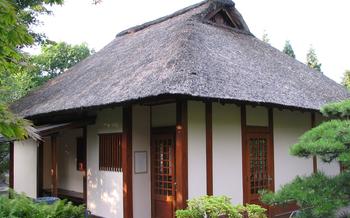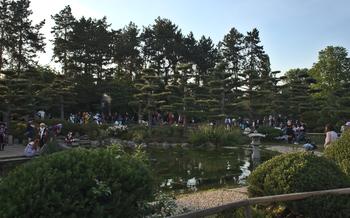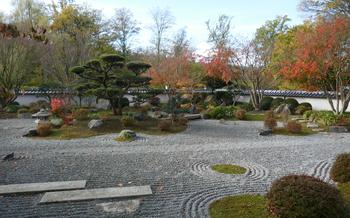
Nordpark Japanese Garden
- Nordpark Japanese Garden: A Haven of Serenity in Mönchengladbach
- Exploring the Garden's Diverse Plant Life
- Admiring the Garden's Tranquil Water Features
- Discovering the Garden's Hidden Corners
- Attending Cultural Events and Workshops
- Capturing the Garden's Beauty Through Photography
- Finding Inner Peace Through Meditation and Mindfulness
- Enjoying a Picnic Amidst Nature's Beauty
- Exploring the Garden with Children
- Appreciating the Garden's Seasonal Transformations
- Visiting the Garden During Special Events
- Respecting the Garden's Rules and Etiquette
- Insider Tip: Unveiling the Garden's Hidden Gem
Nordpark Japanese Garden: A Haven of Serenity in Mönchengladbach
Nestled in the heart of Mönchengladbach, Germany, the Nordpark Japanese Garden is an oasis of tranquility that invites visitors to escape the hustle and bustle of city life. Created in 1912, the garden is a testament to the enduring friendship between Germany and Japan. It was designed by renowned Japanese landscape architect Tassa Eida, who sought to create a space that would reflect the beauty and serenity of traditional Japanese gardens.
The Nordpark Japanese Garden is unique among Japanese gardens in Germany for its authentic design and attention to detail. It features elements such as a traditional tea house, a koi pond, and a rock garden, all of which contribute to the garden's distinctive atmosphere. The garden is also home to a variety of cherry trees, which create a stunning display of pink and white blossoms in the spring.
As one of Mönchengladbach's most significant green spaces, the Nordpark Japanese Garden plays a vital role in improving the city's air quality and providing a habitat for wildlife. It is a popular destination for locals and tourists alike, who come to appreciate its beauty and tranquility.
Exploring the Garden's Diverse Plant Life
The Nordpark Japanese Garden is home to a diverse array of plant life, each carefully selected to create a harmonious and balanced landscape. Visitors can stroll through the garden and admire the vibrant colors and textures of the plants, which change throughout the seasons.
Cherry Trees: A Symbol of Beauty and Tranquility
One of the most iconic features of the garden is its collection of cherry trees. These graceful trees, with their delicate pink and white blossoms, are a symbol of beauty and tranquility in Japanese culture. During the cherry blossom season, the garden transforms into a magical wonderland, attracting visitors from all over the region.
Other Notable Plant Species
In addition to cherry trees, the garden features a wide variety of other plant species, including azaleas, camellias, maples, and pines. These plants are carefully arranged to create a sense of balance and harmony, and they provide a habitat for a variety of birds and insects.
Creating a Harmonious Landscape
The plants in the Nordpark Japanese Garden are not merely decorative; they play an essential role in creating the garden's unique atmosphere. The careful arrangement of trees, shrubs, and flowers creates a sense of depth and perspective, and it helps to guide visitors through the garden's various paths and walkways.
The garden's plant life also contributes to its overall tranquility. The lush greenery and the delicate blossoms create a sense of peace and serenity, making the garden an ideal place to escape the hustle and bustle of city life.
Admiring the Garden's Tranquil Water Features
In Japanese culture, water holds profound symbolic meaning, representing purity, tranquility, and the cycle of life. The Nordpark Japanese Garden pays homage to this rich symbolism through its diverse water features, which add a sense of serenity and dynamism to the landscape.
Visitors can stroll along the winding paths that border the garden's central pond, marveling at the graceful koi fish that glide through the crystal-clear water. The gentle ripples created by their movement create a mesmerizing effect, inviting visitors to pause and appreciate the beauty of the moment.
Another notable water feature is the cascade, which tumbles down a series of rocks, creating a soothing white noise that fills the air. This cascading water not only adds a touch of movement to the garden but also symbolizes the constant flow of time and the transience of life.
Throughout the garden, visitors will also encounter various stone water basins, which serve both a practical and an aesthetic purpose. These basins were traditionally used for purification rituals before entering a tea ceremony, and their presence in the garden adds an authentic touch of Japanese culture.
The tranquil water features of the Nordpark Japanese Garden create a calming and meditative atmosphere, inviting visitors to slow down, let go of their worries, and immerse themselves in the beauty of nature.
Discovering the Garden's Hidden Corners
The Nordpark Japanese Garden is not just a place to admire from afar; it's a place to explore and discover. Beyond the main paths, there are secluded spots that offer a sense of tranquility and intimacy. These hidden corners are perfect for meditation, contemplation, or simply enjoying a moment of peace away from the hustle and bustle of the city.
One such spot is a small teahouse nestled among the trees. Here, visitors can sit and sip a cup of tea while listening to the gentle sound of the wind rustling through the leaves. Another hidden gem is a secluded pond surrounded by lush vegetation. This spot is perfect for observing the local wildlife, such as the colorful koi fish that swim in the pond.
For those who love to explore, there are many other hidden corners to be found in the Nordpark Japanese Garden. Whether it's a secluded bench overlooking the garden or a small waterfall tucked away among the trees, there's always something new to discover. So, take your time, wander off the beaten path, and let the garden reveal its hidden treasures to you.
Attending Cultural Events and Workshops
Beyond its serene beauty, the Nordpark Japanese Garden regularly hosts a variety of cultural events and workshops that provide visitors with a deeper understanding of Japanese culture and traditions. These events range from traditional tea ceremonies, where participants can learn the art of preparing and serving matcha tea, to origami workshops, where they can fold intricate paper creations.
For those interested in Japanese cuisine, cooking workshops are held where participants can learn to prepare authentic Japanese dishes using fresh ingredients and traditional techniques. There are also calligraphy workshops, where visitors can try their hand at writing Japanese characters using a brush and ink, and ikebana workshops, where they can learn the art of Japanese flower arrangement.
These events and workshops are not only educational but also provide a wonderful opportunity for visitors to interact with like-minded individuals who share an interest in Japanese culture. They are also a great way to experience the garden in a different light and gain a deeper appreciation for its beauty and significance.
Capturing the Garden's Beauty Through Photography
The Nordpark Japanese Garden is a photographer's paradise, offering endless opportunities to capture the beauty and tranquility of the natural surroundings. Whether you're a professional photographer or simply an enthusiast with a passion for capturing stunning images, the garden provides a wealth of subjects to inspire your creativity.
To make the most of your photographic experience, consider visiting the garden during the golden hours of sunrise and sunset. The warm, diffused light during these times casts a magical glow on the garden, creating an ethereal atmosphere that's perfect for capturing the essence of the landscape.
When composing your shots, pay attention to the interplay of light and shadow, using them to create depth and drama in your images. Experiment with different perspectives, shooting from various angles to capture unique and dynamic compositions.
Remember to respect the serenity of the garden while taking photos. Avoid using flash photography, as it can be disruptive to other visitors and disturb the wildlife. Instead, rely on natural light and adjust your camera settings accordingly.
Whether you're capturing the delicate beauty of cherry blossoms in spring, the vibrant hues of autumn foliage, or the serene reflections in the water features, the Nordpark Japanese Garden offers a feast for the eyes and a chance to create lasting memories through the lens of your camera.
Finding Inner Peace Through Meditation and Mindfulness
The Nordpark Japanese Garden provides an ideal setting for practicing meditation and mindfulness, allowing visitors to escape the hustle and bustle of city life and find inner peace. The serene atmosphere, coupled with the garden's natural beauty, creates a conducive environment for self-reflection and contemplation.
Guided meditation sessions are occasionally offered in the garden, led by experienced practitioners who introduce participants to various meditation techniques and guide them through the process. These sessions provide a structured approach for those new to meditation or seeking deeper insights into the practice.
Regular meditation in the garden can offer numerous benefits for visitors. It can help reduce stress levels, promote relaxation, and improve overall well-being. By taking a few moments to sit in stillness, surrounded by the tranquil beauty of the garden, visitors can find respite from their daily worries and cultivate a sense of inner calm and serenity.
Enjoying a Picnic Amidst Nature's Beauty
The Nordpark Japanese Garden offers a delightful opportunity to enjoy a picnic amidst nature's tranquil embrace. Designated picnic areas within the garden invite visitors to spread out a blanket and savor a leisurely meal surrounded by serene landscapes.
The pleasure of dining outdoors, surrounded by lush greenery and the gentle sounds of water features, is a unique experience that enhances the overall charm of a visit to the garden. Whether you opt for a simple packed lunch or a more elaborate spread, the garden's picturesque setting transforms any meal into a memorable occasion.
When planning a picnic in the garden, it's important to be mindful of maintaining its tranquility and beauty. Dispose of trash properly, respect other visitors' space, and avoid any activities that may disturb the peaceful ambiance.
Here are some tips to make your picnic in the Nordpark Japanese Garden a memorable one:
- Choose a shady spot under a tree to escape the midday sun.
- Bring a blanket or tablecloth to sit on, as well as cushions or pillows for added comfort.
- Pack a variety of snacks and drinks, including finger foods that are easy to eat outdoors.
- Don't forget to bring water bottles to stay hydrated, especially on warm days.
- If you're feeling adventurous, you can try your hand at making traditional Japanese dishes like onigiri (rice balls) or bento boxes.
- Remember to clean up after yourself and leave the picnic area spotless for the next visitors.
Exploring the Garden with Children
The Nordpark Japanese Garden is a wonderful place to visit with children. There are plenty of activities and attractions to keep them entertained and engaged while also providing them with a unique educational experience.
One of the highlights for children is the playground, which is designed to resemble a traditional Japanese village. Here, they can climb on nets, swing on unique structures, and explore the many hidden corners.
The garden also features a children's pond, where they can feed the friendly koi fish. This is a great opportunity to teach them about the importance of kindness to animals and the delicate balance of ecosystems.
Additionally, the garden offers educational programs tailored specifically for children.
Appreciating the Garden's Seasonal Transformations
The Nordpark Japanese Garden is a living masterpiece that undergoes constant transformations throughout the year, reflecting the changing seasons. Each season brings its own unique charm and beauty to the garden, making it a place that can be enjoyed and appreciated all year round.
Spring is undoubtedly the most popular time to visit the garden, as it is the season of the cherry blossoms. The garden's many cherry trees burst into bloom, creating a breathtaking spectacle of pink and white blossoms that draws visitors from far and wide. The sakura (cherry blossom) viewing tradition is a centuries-old Japanese custom that celebrates the beauty and transience of life, and the Nordpark Japanese Garden offers a wonderful opportunity to experience this tradition firsthand.
Summer brings a lush green canopy to the garden, as the trees and plants reach their full height. The water features come alive with the sound of cascading water, adding to the tranquil atmosphere. This is an ideal time to stroll through the garden's paths, seeking respite from the summer heat under the shade of the trees.
Autumn transforms the garden into a fiery tapestry of colors, as the leaves of the trees turn vibrant shades of red, orange, and yellow. The momiji (autumn foliage) viewing tradition is another popular Japanese custom, and the Nordpark Japanese Garden offers a stunning display of autumn colors that rivals the best in Japan.
Winter brings a serene and contemplative atmosphere to the garden, as the snow blankets the landscape in a pristine white coat. The garden's evergreens and bare branches create a striking contrast against the snow, and the water features take on a new and icy beauty. This is an ideal time to visit the garden for those who seek peace and tranquility amidst the winter wonderland.
No matter what time of year you visit, the Nordpark Japanese Garden offers a unique and unforgettable experience. Its seasonal transformations make it a place that can be enjoyed and appreciated over and over again.
Visiting the Garden During Special Events
The Nordpark Japanese Garden comes alive during special events, offering visitors a chance to experience Japanese culture in a festive atmosphere. The annual Cherry Blossom Festival, held in spring, is a highlight, attracting locals and tourists alike. During the festival, the garden is adorned with colorful decorations, and visitors can enjoy traditional Japanese music, dance performances, and food stalls.
Other seasonal events include the Autumn Foliage Festival, held in fall, and the Winter Light Festival, held during the holiday season. These events showcase the garden's beauty in different seasons and offer unique experiences for visitors. Whether it's admiring the vibrant cherry blossoms, marveling at the fiery autumn foliage, or strolling through the garden illuminated by lanterns, there's always something special to discover during these events.
By attending these special events, visitors can immerse themselves in Japanese culture, witness traditional performances, and savor delicious Japanese cuisine. It's an opportunity to celebrate the beauty of the garden and experience the rich cultural heritage of Japan. Make sure to check the garden's website or social media pages for upcoming events and plan your visit accordingly.
Respecting the Garden's Rules and Etiquette
The Nordpark Japanese Garden is a cherished space that relies on the cooperation of visitors to maintain its tranquility and beauty. To ensure a harmonious experience for all, certain rules and etiquette are expected from those who visit the garden.
Maintain Silence and Tranquility: - The garden is a place of serenity and contemplation, where visitors are encouraged to speak softly and avoid loud noises. This allows everyone to fully immerse themselves in the garden's peaceful atmosphere.
Stay on Designated Paths: - To protect the delicate vegetation and preserve the garden's layout, visitors should remain on the designated paths. Stepping off the paths can damage plants and disrupt the overall harmony of the garden.
Respect the Plants and Wildlife: - The garden's plants and wildlife are essential to its beauty and ecological balance. Visitors should refrain from touching or picking the plants and avoid disturbing the animals that call the garden home.
No Smoking or Littering: - Smoking and littering are strictly prohibited within the garden. These activities not only detract from the garden's natural beauty but can also pose a fire hazard. Visitors are encouraged to dispose of waste responsibly in designated bins.
Follow Group Guidelines: - For larger groups visiting the garden, it is essential to maintain order and minimize disruption to other visitors. Group leaders should ensure that their members adhere to the garden's rules and etiquette.
By following these guidelines, visitors can help preserve the Nordpark Japanese Garden for future generations to enjoy. It is through collective respect and care that this serene oasis can continue to offer a sanctuary of peace and tranquility amidst the bustling city.
Insider Tip: Unveiling the Garden's Hidden Gem
Beyond the main paths and serene water features, the Nordpark Japanese Garden holds a hidden gem that often goes unnoticed by visitors. Tucked away in a secluded corner, amidst towering trees and vibrant foliage, lies a charming teahouse known as the "Azumaya." This traditional Japanese structure, with its elegant wooden architecture and thatched roof, offers a tranquil retreat where visitors can immerse themselves in the garden's beauty and serenity.
The Azumaya teahouse is a place of contemplation and mindfulness, where one can sit back, sip a cup of tea, and let the worries of the world melt away. Surrounded by the gentle sounds of nature and the rustling of leaves, visitors can find solace and peace amidst the bustling city.
To discover this hidden gem, take a leisurely stroll along the garden's winding paths, allowing yourself to get lost in the tranquil ambiance. Keep an eye out for a small signpost that points the way to the Azumaya teahouse. As you approach, you'll be greeted by a serene atmosphere that invites you to slow down, appreciate the moment, and connect with the natural world.
Whether you're seeking a moment of solitude or a unique experience to share with friends, the Azumaya teahouse is a must-visit destination within the Nordpark Japanese Garden. Embrace the opportunity to discover this hidden gem and create lasting memories in this enchanting oasis of peace and tranquility.









